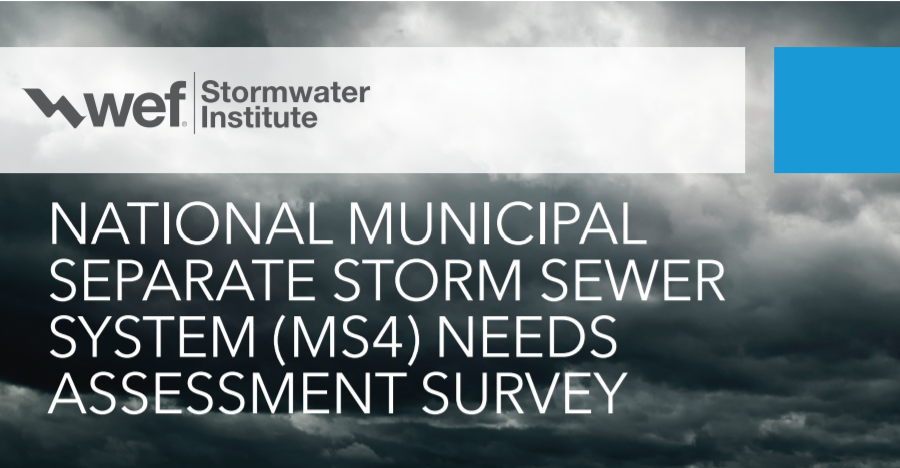During WEFTEC Connect, experts leading national efforts to fill stormwater-sector data gaps, improve the sector’s financial stability, and identify common needs among different types of stormwater managers discussed the state of the U.S. stormwater sector in a series of webcasts.
National Municipal Stormwater Alliance (NMSA; Alexandria, Virginia) Executive Director Seth Brown and Water Environment Federation (WEF; Alexandria, Virginia) Government Affairs Director Steve Dye provided updates on federal stormwater policy; efforts to provide standardized metrics for evaluating stormwater products and practices; and the first nationwide survey of common stormwater-sector needs.
Recordings of the webcasts, each only about 15-20 minutes, are now available to the public.
Legislation in the Works
This year saw several developments at the national level for the U.S. stormwater sector, Dye described during a Federal Stormwater Policy Update webinar. With several more actions currently under negotiations by the federal government, the final months of 2020 likely will prove eventful.
In May, the U.S. Senate passed the America’s Water Infrastructure Act of 2020, which contained several provisions for the stormwater sector. For one, it would reauthorize the Clean Water State Revolving Fund program for between $2 billion and $3 billion for each of the next three years, as well as expand the program to enable recipients to finance both wastewater and stormwater infrastructure. The measure also includes language that would reauthorize the Water Infrastructure Finance and Innovation Act and establish new grants for the stormwater workforce as well as infrastructure planning, development, and implementation.
The U.S. House of Representatives also passed a large infrastructure package in July known as H.R. 2: The Moving Forward Act. The measure, providing about $1.5 trillion in total to various sectors, would include about $1 billion in resilience grants to wastewater facilities that would apply to stormwater projects. It would also establish a new program within the U.S. Department of the Interior focusing on water workforce development. In addition to reauthorizing State Revolving Funds for clean water and drinking water by a total of $13 billion, the bill would also create a $500-million grant program for developing Smart Water technologies.
Both bodies of Congress are now negotiating the particulars of each bill, expecting to incorporate parts of both into a forthcoming Water Resources Development Act (WRDA) by the end of 2020. While both bills would provide “a sizeable bump in the amount of funding going to communities across the country for water infrastructure,” a deal on WRDA “isn’t imminent,” Dye said during the webcast.
“Unfortunately, there are a lot of things that are up in the air right now,” Dye said. “As the year comes to a close, there are opportunities for stormwater policy to benefit at a national level, and hopefully we’ll start to see some of these things come together.”
Watch the full Federal Stormwater Policy Update webinar below.
Moving Forward on STEPP
Lacking standardized measures at the national level to gauge the effectiveness of stormwater projects and programs across different climates and circumstances, the U.S. market for stormwater technologies is currently fragmented. For equipment manufacturers, utility consumers, and regulators, the difficulty of evaluating performances between different products is a barrier to innovation that ultimately affects water quality.
Since 2015, the WEF Stormwater Institute has managed the Stormwater Testing and Evaluation of Products and Practices (STEPP) program, which is laying the foundation for standardized performance metrics for the U.S. stormwater sector.
The STEPP program has already attracted a group of expert stakeholders from across the sector, who formed an official working group in 2017. Members of the group include organizations such as the American Society for Testing Materials (West Conshohocken, Pennsylvania), the Water Research Foundation (Alexandria, Virginia), and the State of Washington Department of Ecology.
STEPP members continue to work toward implementation, gradually forming additional partnerships with stormwater permittees, regulators, and researchers. The group is currently working in Minnesota to build a state-wide model for integrating STEPP standards into stormwater codes. The team will use findings from their pilot in Minnesota to inform metrics that can be used in other states, or even at the federal level.
Currently, STEPP is headquartered at the WEF Stormwater Institute. However, Brown said during a webcast about STEPP that NMSA is considering taking the reins of the program. WEF stormwater professionals would still play a key role in the program moving forward, Brown said.
Watch the full STEPP Program update webinar below.
MS4 Survey Results Coming Soon
The nature of the stormwater sector makes data collection difficult, Brown described, since the specific forms and goals of stormwater management organizations can vary so widely. At a national level, the stormwater sector is markedly data-poor, leaving federal legislators unarmed with the knowledge they need to become more involved in stormwater regulation.
In a third webcast, Brown provided an update on the National MS4 Needs Assessment Survey, which will produce results from its second installment by the end of 2020. Conducted for the first time in 2018, the biennial survey is the first effort of its kind to gauge common challenges and operating conditions among U.S. stormwater permittees.
The 2020 survey, conducted earlier this year, received responses from 804 MS4 permittees from 49 states, Washington, D.C., and Puerto Rico, creating a statistically significant sample that enables trend analysis. After the success of both the 2018 and 2020 surveys, the American Society of Civil Engineers (ASCE; Reston, Virginia) plans to use gathered data to include a stormwater category in its 2021 Infrastructure Report Card, released every four years.
In general, the 2020 survey revealed that Phase I permittees typically have higher budgets for stormwater programming than they did in 2018, while Phase II respondents have slightly lower budgets. The size of the average budget for stormwater programming by state-level departments of transportation has nearly doubled since 2018. However, in 2020, about 60% of both Phase I and Phase II permittees reported that they are deferring necessary expenditures due to lack of funding, a figure up by about 10% since 2018. Based on data from this year’s survey, experts from WEF and NMSA estimate that the total funding gap for the U.S. MS4 sector is about $8 billion.
Visit the WEF Stormwater Institute website for more details on the release of results from the 2020 MS4 Needs Assessment Survey and watch the full webcast about the survey below.
ABOUT THE AUTHOR
Justin Jacques is editor of Stormwater Report and a staff member of the Water Environment Federation (WEF). In addition to writing for WEF’s online publications, he also contributes to Water Environment & Technology magazine. Contact him at jjacques@wef.org.
















